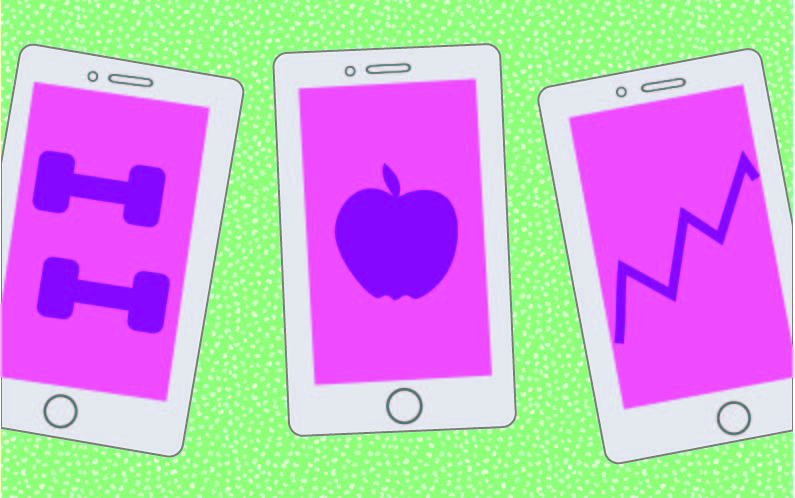Medical apps and the future of diagnostics.
by Aparna Vidyasagar
illustration by Sara Dennis
Phones are a constant accessory for many of us. It’s not surprising, considering the versatility and technological prowess of today’s mobile devices. Researchers and medical professionals are tapping into this technological potential to develop medical apps. In turn, these applications are changing the ways in which we can access healthcare.
Medical apps are designed to improve health. Broadly speaking, they fall into two categories. First, there are apps that help us manage our health such as food logs, pill reminders, or apps that provide medical information like the National Institutes of Health’s (NIH) AIDSinfo apps, which provide a glossary of AIDS-related terms, and drug information.
Then there are apps that can collect data. These apps also act as a conduit between patients and medical professionals, potentially aiding in diagnosis. All this, without having to leave our homes.
For example, researchers at the University of Washington recently developed ApneaApp, an Android phone app designed to detect sleep apnea. Those with the condition experience disrupted sleep, punctuated by shallow breathing or pauses in breathing. In order to be diagnosed with the condition, one would have to visit a sleep clinic and spend a night hooked up to machines and sensors to detect abnormal breathing. Instead, the app works in a manner similar to sonar.
“We send inaudible signals—sound signals— [from the phone]. These audio signals get deflected off of our body,” says Rajalakshmi Nandakumar, the lead author of the study. “When you are breathing, your chest and abdomen move by a few centimeters,” she further explained. Essentially, the app monitors changes in chest movement by measuring how long it takes for the deflected sound waves to reach the phone again.
Another app, GaitTrack, was developed in 2014 at the University of Illinois at Urbana-Champagne specifically for patients with chronic heart and lung diseases. The app analyzes gait or walking patterns like shuffling and short steps, which could be indicative of a decline in the health of patients with chronic heart and lung diseases. The app then notifies the patient or the doctor. Both apps have moved into further optimization phases. So far, ApneaApp has been tested in a 37-person clinical study where it was compared to a conventional sleep test (polysomnography). Nandakumar says that the app is being tested in the home environment, and they are also working on an iOS (Apple) version of the app. GaitTrack will be tested in larger trials according to a press release.
In March of this year, Apple showed its confidence in the future of mobile health by unveiling ResearchKit, a toolkit for those looking to build medical apps. ResearchKit can connect researchers with the vast number of iPhone users (in terms of sales, Apple sold its 500 millionth iPhone in March 2014), and it promises to circumvent an old problem: how to recruit a large, representative pool of participants.
But with patient access comes oversight; specifically by the Food and Drug Administration (FDA). The FDA released its latest set of guidelines in February of this year. Their overarching goal is to minimize risk, stating that their focus was “only on the apps that present a greater risk to patients if they don’t work as intended and on apps that cause smartphones or other mobile platforms to impact the functionality or performance of traditional medical devices.”
For Nathaniel Watson, a neurologist and sleep specialist at the University of Washington, who is also a part of the ApneaApp team, there is a tug-of-war between the pace at which mobile technology and medical technology move. “I think the challenge is going to be the tension between the fact that this space [mobile technology] moves so quickly, that often there isn’t enough to pursue the studies and FDA approval that are necessary for [an application] to be a legitimate diagnostic test,” Watson says. Apps like ApneaApp and GaitTrack can detect abnormal health patterns in individual patients, but they aren’t stand-alone diagnostic tools. Ultimately, they serve to equip patients with the information necessary to consult their physicians.
Still, medical apps present a two-way street paved with promise. Researchers and medical practitioners gain access to large amounts of data and improved connectivity with their patients. On the other hand, the users gain accessible and perhaps even affordable healthcare support.
“People are very interested in driving their own health care and assessing their health,” says Watson.
[hr style=”striped”]
Aparna Vidyasagar is a freelance science writer who writes about life-sciences research and health. She lives in Portland, Oregon. Follow her on Twitter.
Sara Dennis is an illustrator and design student at the University of Missouri. For more artwork or general doofiness, check out her website or Twitter.



